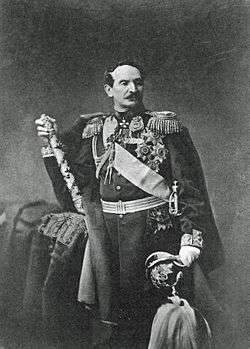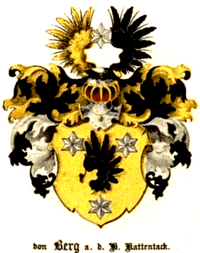Friedrich Wilhelm Rembert von Berg
| Graf Friedrich Wilhelm Rembert von Berg | |
|---|---|
 General-Field Marshal Friedrich Wilhelm Rembert von Berg, c. 1870 | |
|
In office 19 December [O.S. 7] 1854 – 20 November [O.S. 8] 1861 | |
| Monarch |
Nicholas I Alexander II |
| Preceded by | Alexander Menshikov |
| Succeeded by | Platon Rokassovsky |
|
In office 31 October [O.S. 19] 1863 – 18 January [O.S. 6] 1874 | |
| Monarch | Alexander II |
| Preceded by | Grand Duke Konstantin Nikolaevich |
| Succeeded by | Position abolished (Paul von Kotzebue as the Governor-General of Warsaw) |
| Personal details | |
| Born |
15 May [O.S. 26] 1794 Sangaste Manor (Sangaste Manor, Sangaste, Governorate of Livonia, Russian Empire |
| Died |
6 January [O.S. 18] 1874 (aged 79) Saint Petersburg, Russian Empire |
| Signature |
 |
| Military service | |
| Allegiance |
|
| Service/branch |
|
| Years of service | 1812 – 1874 |
| Rank |
|
| Battles/wars |
Napoleonic Wars Russo-Turkish War (1828-1829) November Uprising Crimean War January Uprising |
| Awards |
Russian: Foreign: |
Friedrich Wilhelm Rembert Graf[1] von Berg (Russian: Граф Фёдор Фёдорович (фон) Берг, Graf Fyodor Fyodorovich (von) Berg; 15 May [O.S. 26] 1794 – 6 January [O.S. 18] 1874) was an Baltic-German nobleman, statesman, diplomat and military officer who served in the Imperial Russian Army, he was a count of Austria (from 9.1849) and Finland[2] (from 26.8.1856), and was the 5th last General-Field Marshal (promoted in 1866) in the history of the Russian Empire. He was the Governor-General of Finland[3] from 19 December [O.S. 7] 1854 to 20 November [O.S. 8] 1861 and the last Viceroy of the Kingdom of Poland from 31 October [O.S. 19] 1863 to 18 January [O.S. 6] 1874. He was also a scientist and geographer who engaged in topography and geodesy.[4]
Family


The Lutheran[5] Berg family (ru) (Swedish: Berch) first appeared in Livonia sometimes between the 15th century and 16th century, and the family’s origin still remained unknown to this day, but many theorized that they originated from Westphalia in the Holy Roman Empire (now the part of the German state of North Rhine-Westphalia), then part of the Duchy of Berg, and may had ties to the counts and dukes of Berg. The earliest known ancestors of the family was Otto von Berg, Otto’s son was a member of the Livonian Order. Many of his descendants splitted into branches and emigrated to other countries such as the Netherlands and England.
And in the 17th century, the Livonian branch of the Berg family broke into the senior and junior branch. The head of the senior branch, Jakob Friedrich von Berg, who was a cuirassier in the Imperial Russian Army. The branch was then continued by his son, one of his descendants, Waldemar Cuno von Berg (1842-1905), was a vice-admiral in the Imperial Russian Navy, he had commanded the cruisers Boyarin, Asia, General Admiral and Pre-dreadnought battleship Poltava. While the more famous junior branch, the head of the branch, Gustav von Berg (1657-1710), who served in the Swedish Army as a captain. At that time, Casper Johann (died 1761), a Swedish captain, was granted nobility of count (Greve in Swedish and Graf in German). The branch was then continued by his son Gottard Wilhelm (1682-1756), also a captain in the Swedish Army. His great-grandson, Friedrich Georg (1763-1811, Friedrich Wilhelm Rembert’s father), was a state counselor in the Russian Empire, and was the first owner of the Sangaste Manor (et).
Biography
Early life
Friedrich Wilhelm Rembert von Berg was born May 15, 1794 in the Sangaste Manor (et) in the Russian Empire into the noble Baltic-German von Berg and was of Lutheran faith. His father was Friedrich Georg von Berg, state counselor, and his Gertrude Wilhelmine von Hermes, who was also a Baltic-German noblewoman. Friedrich was the oldest of 4 brothers, his younger brothers were: Gustav Gotthard Karl (1796-1861), Magnus Reinhold Christoph (1799-1879) and the youngest brother Alexander (1893-1884).
Early career
At the age of 19, he originally attended the University of Dorpat and did not join the army at first, but when the young student heard of the French troops entering Russian soil, he immediately dropped his classes and joined the army.
Honours and awards
.png)

.png)



.png)


Foreign
.svg.png)





.svg.png)



.svg.png)

Children
In 1856 Fredrik Wilhelm adopted his brother's two sons:
- Friedrich Georg Magnus von Berg (1845–1938), "The count of rye", developer of Estonian agriculture
- Georg Erik Rembert Berg (1849–1920), Finnish general in the Imperial Russian Army
Publications
- Le feldmaréchal-comte Berg, namiestnik dans le royaume de Pologne. Notice biographique. Warsaw 1872 – Autobiography
References
- ↑ Regarding personal names: Until 1919, Graf was a title, translated as Count, not a first or middle name. The female form is Gräfin. In Germany since 1919, it forms part of family names.
- ↑ Grevliga ätten nr 11 BERG – Finnish House of Nobility
- ↑ Governors-general of Finland
- ↑ http://chestofbooks.com/reference/American-Cyclopaedia-5/Friedrich-Wilhelm-Rembert-Von-Berg.html
- ↑ The Germans in the civil service in the Russian Empire in the XIX century
Sources
- Berg (von Berg), Fredrik Wilhelm Rembert (in Finnish)
| Political offices | ||
|---|---|---|
| Preceded by Alexander Menshikov |
Governor-General of Finland 1855–1861 |
Succeeded by Platon Rokassovsky |
| Preceded by Grand Duke Konstantin Nikolaevich |
Viceroy of Poland 1863–1874 |
Succeeded by Paul Kotzebue as Governor-General of Warsaw |
| Wikimedia Commons has media related to Friedrich Wilhelm Rembert von Berg. |